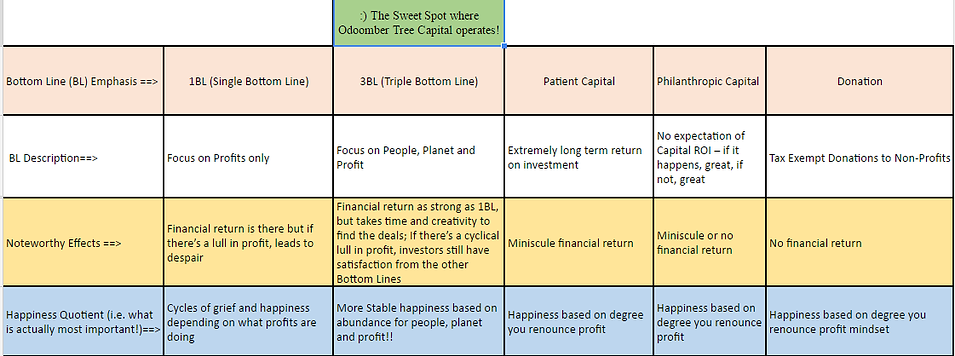Philosophical Foundations of Our Investment Thesis
Table of Contents
Deep Wealth Investment Framework (DWIF)
Spectrum of which Bottom Lines are emphasized when placing capital
Deep Wealth Investment Framework (DWIF)
In today’s real estate, there are all kinds of profit-sharing investment frameworks for the various entities involved in a joint venture. You’ll hear about Waterfall and the “Promote” which compensates the Sponsor (or operator) at various amounts based on certain profit targets being hit.
At Odoomber Tree Capital, we find many of these investment frameworks to be too complex (in terms of time required to track the Promotes) for the hands-off partners involved in our Triple Bottom Line joint ventures.
We also felt there is a need for an investment framework more congruent with a higher order of the concept of “economy” that is recognized by awake, conscious individuals who invest with us.
So we designed the Deep Wealth Investment Framework (DWIF)!
The name is an homage to the concept of Deep Wealth as put forward by the Metacurrency project. (see diagram here, a prezi here, and here video here). While we highly encourage you to explore those links, we’ll provide a brief gist here. “Deep Wealth” understands “currency” as “seeing a current”, i.e. a flow, and Deep Wealth thus understands that there are vastly more higher order types of “currencies” than only monetary currencies.
A salient feature of DWIF is a recognition of a more expansive spectrum associated with the concept of “Currency” than is generally recognized in the mainstream today.
With that baseline understanding, the DWIF begins by asking a simple question:
What are the causative factors, i.e. who injected what currencies into the deal, which resulted in the Joint Venture controlling the property, thus resulting in the cashflow in the first place?
We identify two causative factors:
-
“Reputation Currency” (aka “Good Credit History”) which transforms into a loan of a certain monetary value being issued.
-
“Monetary Currency” (aka US Dollars) which also obviously has a monetary value.
Both Reputation Currency and Monetary Currency have monetary value and both are equally needed to gain control of the property. In the DWIF, this is taken into account when considering who owns what portion of the controlling LLC.
Here’s where OTC’s and our partners’ interests are:
-
We all are interested in a simple streamlined investment framework that is not time consuming to monitor
-
We all are interested in an ability to clearly focus on the Triple Bottom Line (3BL) without being pulled counterproductively into any one BL by a bureaucratic emphasis on how to calculate it.
In real estate joint ventures there is often mention of the need to have an alignment of interests. At Odoomber Tree Capital, we feel DWIF accomplishes true alignment of interests. DWIF is hassle-free and more fair and equitable to all JV partners than today’s mainstream investment frameworks. With the elegance of the DWIF solution, we’re confident you’ll receive a true, professionally managed Triple Bottom Line Return on your Investment (ROI).
Now let’s move on to the next topic…
Spectrum of which Bottom Lines are emphasized when placing capital
Another philosophical foundation to be familiar with to understand our investment thesis is the following spectrum of which Bottom Lines are emphasized when placing capital. Notice where our sweet spot is!
Metrics for Measurable Impact
another philosophical foundation to understand
The space of Triple Bottom Line investing has been called “Mission Investing”, SRI (Sustainable Responsible Impact) Investing, or now more recently simply “Impact Investing”. It’s important to note that when we at Odoomber Tree Capital talk about delivering Triple Bottom Line returns, it isn’t merely fluff. During the course of your investment, we will provide you real tangible metrics (or “KPI’s” – key performance indicators) that describe what kind of impact we’re having.
There is an entire body of work devoted to measuring social and planetary impact. Odoomber Tree Capital will be referring to the IRIS Catalog of the Global Impact Investing Network (GIIN) when providing you updates.
“IRIS is the catalog of generally accepted performance metrics that leading impact investors use to measure social, environmental, and financial success, evaluate deals, and grow the sector’s credibility.”
We invite you to explore their catalog and website in general. Another good resource is this talk by Rob Hanna called Measuring Social Impacts to Scale Social Innovations.

